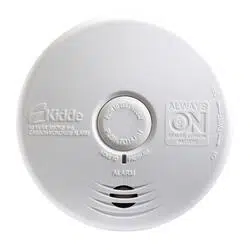Loading ...
Loading ...
Loading ...

6. Alarm Visual and Audible Indicators
The following table describes the visual and audible alarm conditions the unit
may encounter and illustrates how the unit will indicate normal standby, alarm
and error conditions.
Alarm
Mode
Visual
Indications
Audible
Indications
Smoke or Fire detected 3 blinks synchronized with audible alarm 3 long beeps, repeating
Carbon Monoxide
detected
4 blinks syncronized with audible alarm 4 quick beeps, repeating
5. OPERATION AND TESTING
OPERATION: The alarm is operating once it is activated and testing is complete.
When products of combustion are sensed, or CO is detected the unit sounds a
loud 85db pulsating alarm until the air is cleared.
The carbon monoxide (CO) alarm monitors the air for the presence of CO. It will
alarm when there are high levels of CO present, and when there are low levels
of CO present over a longer period of time. When a CO condition matches
either of these situations, the alarm will sound, and be accompanied by the
blinking red LED light.
The CO sensor meets the alarm response time as follows:
At 70 PPM, the unit must alarm within 60-240 minutes.
At 150 PPM, the unit must alarm within 10-50 minutes.
At 400 PPM, the unit must alarm within 4-15 minutes.
TESTING: Test your alarm by pressing the test button until the unit chirps,
then release the test button. The unit will then emit 2 sets of three long beeps
followed by 2 sets of four quick beeps indicating that the alarm is operating
normally. The alarm will sound if the electronic circuitry, horn, and battery are
working. If the alarm does not sound, the unit must be replaced.
Warning: Due to the loudness (85 decibels) of the alarm, always
stand an arm’s length (about 2.5 feet) away from the unit or use ear
protection when testing.
Weekly testing is required to ensure proper operation. Erratic or low
volume sound (or no sound) coming from your alarm may indicate a defective
alarm and it should be returned for service. See PERMANENTLY DISABLE ALARM
/ DISCHARGE BATTERY section to determine how to prepare the unit for ship-
ment or disposal.
Warning: DO NOT use an open flame to test your alarm, you could
damage the alarm or ignite combustible materials and start a structure fire.
Loading ...
Loading ...
Loading ...
